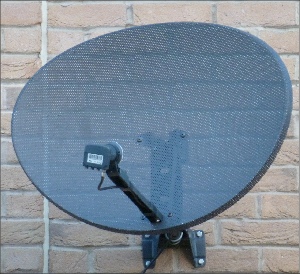
Splitting signals from a satellite dish
The problem with splitting signals from a satellite dish to a number of receivers (as opposed to the signals from one satellite receiver to a number of TVs using a modulated RF signal) is that the LNB on the dish can work in four different modes according to which satellite programme is being tuned into by the box. The four modes are:
Horizontal polarity - high band
Horizontal polarity - low band
Vertical polarity - high band
Vertical polarity - low band
Straight away one can see that if (to receive the desired programmes) the receivers happen to require different modes at the LNB then that is impossible, and that is why you can't reliably split the signal from one LNB to a number of receivers.
However, life is never as simple as that.If two receivers linked to one LNB by a splitter, are, by pure chance, tuned to channels which both require the same mode (e.g. horizontal polarity high band) then both receivers may well work fine, assuming the signal is large enough to still work after losing 5 to 6dB through the splitter.
Furthermore, if the LNB is split to two points but only one receiver is ever in use, then that too can work, again subject to there being enough signal to cope with the splitter loss (5 to 6dB at satellite IF frequencies). In both cases the splitter must be capable of working up to satellite frequencies (not all are) and have power pass on both outputs, the internal F conn splitters we sell fulfil both criteria.
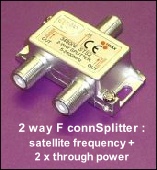
Some people just want an alternative point to use their satellite box or PVR. Thus they don't actually need to split the signal at all if they use looping cables as in the diagram. Don't use cheapo crappy unscreened wall plates though, use decent screened ones like these. [link]
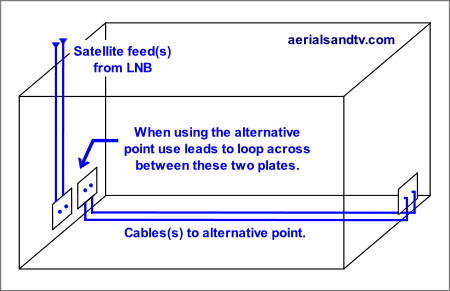
So, if one LNB can only supply one receiver, the obvious question is, how do you supply signals to multiple receivers (or even one Sky+ box, which needs two separate feeds)? After all blocks of flats haven't got hundreds of dishes on the side walls have they? Not usually anyway.
There are two ways round this, one LNB can have multiple outputs, two, four or eight being the commonest, though I have to say having four, or even worse, eight, cables coming out of your satellite dish and down your wall, can look pretty crap. You can make it look neater by using twin sat cable, but an eight way would still need 4 lots of twin cable....... We sell 4 way (Quad) LNBs, though you don't have to use all four outputs if you only require two at the time you fit the system.
The other way, used in most large systems in flats, is to use a Quattro LNB (which supplies all four modes of LNB operation simultaneously) linked to a multiswitch. The latter then needs a separate cable from each of its outputs to every receiver (or two to every Sky+ box), but it can then supply any of the 4 LNB modes as required by each of the receivers. These are not simple setups and the dish should be 80cm or more to increase the signal to noise ratio (though 60cm can be used if desperate and the dish is close to the multiswitch), i.e. not just a standard Sky dish, which the Quattro LNB wouldn't fit onto anyway. Whilst we do sell Zone 1 and 2 satellite dishes and Quad LNBs we do not sell Quattro LNBs or multiswitches.
If you're going to all that trouble to get Freesat, I have to say it'd be a lot simpler, and cheaper, to install an aerial system capable of receiving Freeview...
Satellite reception : basic technical data
The low band frequencies (into the LNB) are from 10.7 to 11.7GHz and high band frequencies are from 11.7 to 12.75Ghz. These are down converted in the LNB by the use of a local oscillator into satellite IF, ranging from 1 to 2GHz. This is the signal which travels down the cable into the satellite receiver.
Horizontal polarity is selected by the receiver supplying 18 volts to the LNB, vertical polarity by the receiver supplying 13V to the LNB.
High band is switched on by a 22kHz tone being sent to the LNB by the receiver, and low band by the absence of that tone.
Thus it can be seen that if two receivers (connected to one LNB via a splitter) both want different modes from the LNB certain priorities apply. If either receiver has the 18 volts switched on (for horizontal polarity, as opposed to the 13 volts for vertical polarity) then horizontal polarity will be switched on at the LNB. Similarly with high band and low band, if either receiver has the 22kHZ switched on then that is what the LNB will switch to.
Sky Digiboxes : general info (not Sky Q)
Accessing the hidden service menu, used for switching on RF2, and/or, altering the frequency / channel of the RF2 output (if fitted).
Be very careful what options you change in these menus, particularly the satellite dish settings!
Standard (original) box = (press) Services > 4 > 0 > 1 > Select
Sky HD box = Services (options menu) > (highlight “Settings” [spanner]) Select > (highlight “Picture”, then press) 0 > 1 > RF Outlets > Select
The modulated output (from RF2) on most Sky boxes or I/O links is about 70 dBµV, which equates to a medium strength signal, and as such it can often feed two points with a passive splitter, provided the cable runs aren't too long. Note that if the Digi Link system is required this will not usually work through a splitter, even one with power pass, see below.
The “loop through” RF (from the aerial) is usually amplified slightly, about 4 dB, which is about the loss you'd get through a 2 way splitter. Thus if the output from the RF2 is fed into a 2 way splitter you'll end up with what you had at the input to the Sky box, this obviously excludes any losses in the cable run(s).
FM and DAB signals as well as TV can also be looped through the Sky digibox, as they can through Digilink amps.
The 9v (and, often, the IR return path signals) from the RF2 output on the Sky box will pass through a splitter (e.g. an F conn splitter) with power pass, but only from the output to the input, i.e. not in the direction required to actually use the splitter as a splitter ! However, it should be noted that certain types of 2 way CoAx splitters (e.g. the ones we sell) seem to work the Digilink system [when only splitting 2 ways]. It's not really recommended and you will obviously only get half the signal out of each leg, but you could experiment to see if it works for you, if you're really that desperate to save £15 odd. If you need to feed more than one point and require Digi eyes to work the correct method is to use a Digilink amp.
Fault finding on a Sky Digilink distribution system
If your digieye(s) stop working the first thing you should do is plug it straight into the Sky box (or the I/O link* ), but make sure it's fitted the correct way or it won't work. Obviously, assuming the eye is OK, if the it doesn't work there the problem is box or I/O link related (possibly the output on the RF2 output has been deselected) so there probably isn't anything wrong with the cabling and any amplifier further down the line. If the eye does work when correctly plugged into the Sky box then move it down the line (e.g. the input to any amplifier) and try again, repeat until the point at which operation ceases has been reached, that's normally the fault area. Our eyes and remote powered amps have LEDs fitted so this makes fault finding easier, if the LED is lit (denoting presence of the DC output from the Sky box) then normally the RF signal is also present. I have to say that in all the years we sold them we never had a 4 way digilink amp that was faulty (we had a few sent back “faulty” but when we tested them they were fine). This is what you'd expect because when any amplifier fails (or indeed many electronic products) it's the power supply section which is most likely to be the culprit, and on a remote powered amp the power supply is in the Sky box!
* Digilink systems use the I/O link since Sky helpfully (not….) deleted the RF outputs on their digiboxes from August 2013.
Should I fit a zone 1 or a zone 2 dish ?
A Zone 1 dish is approx 43cm x 58cm where as a Zone 2 dish is approx 56cm x 75cm.
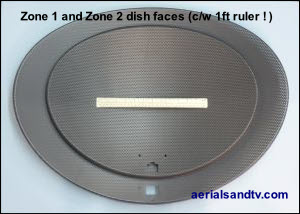
A Zone 1 dish is smaller than a Zone 2 so therefore has less wind loading.
On the other hand a Zone 2 dish has about 2dB higher gain so should give you a more reliable signal, e.g. less chance of "rain fade" and can send the signal down a longer cable run (see recommended max distance below).
Because the Zone 2 dish has a higher gain (and therefore a smaller acceptance angle) alignment of it is more critical. Obviously the great majority of people fit the Zone 1 dish, and apart from a bit of "rain fade" they generally work acceptably.
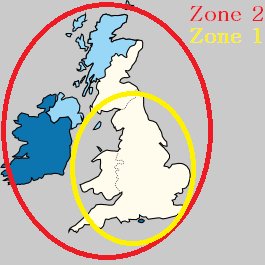
It is recommended that all sites in Scotland use a Zone 2 dish, though this isn't a cut and dried issue. As you go further north the satellites footprint will mean the signal will diminish, so I wouldn't have thought there'd be much difference between northern England and southern Scotland.
A Zone 1 dish may well work OK in Scotland but be more susceptible to rain fade.
The maximum recommended distance from a dish to a Sky receiver (using copper copper cable) is approximately :
50m with a Zone 1 dish.
60m with a Zone 2 dish.
Theoretically the receiver may work at up to twice these distances but it's not recommended. These distances would be slightly less with RG6 type cable and significantly less with the thinner 4.5mm stuff which is often used by some tight arse aerial installers.

